The Science of Star Wars
Every year I give a talk at the St. Louis Science Center -- I’ve given them on the Science of Avatar, What Would Life On Other Planets Be Like (with a Star Trek theme), and the Science of Doctor Who. But this year, I chose to talk about the science of my favorite movie of all time -- STAR WARS! I also got to screen the 1977 original (i.e. not Special Edition) in the Omnimax theater! Fans came out in costume, and it was a really fun event -- here are some pictures.

It has taken me a while, but I finally wrote up my talk. My talk actually also had plenty of stuff from THE EMPIRE STRIKES BACK in it, but I’m going to save that for a future article.
Space Fantasy
Star Wars is space fantasy, so why are we talking about the science? I know it makes no sense that there is sound in space, the ships fly like airplanes, and most characters appear human. But those things were deliberate choices that made it a better movie, so I’m all for them. Instead, I’d rather look a scientific blunders -- things they unnecessarily got wrong, or the visionary ideas that foretold the future.
And of course, this is just for fun -- I’m not advocating for realistic lightsabers, but I think it is kind of neat that we can actually compute how possible they are. We can take this common mythology that we all share and use it to illustrate how we can calculate seemingly unknowable things. And the movie has inspired real-world technology. I was inspired to be an astronomer by watching STAR WARS at a young age, and all over the world, scientists have drawn on it for inspiration to create cool new things.
I’ll go through things roughly in the order they appear in the film.
Droids
After the famous opening crawl and space chase, the first thing we see are two of the most iconic characters from the series, C3P0 and R2D2. Of course androids are as old as science fiction, but the droids of the Star Wars universe are very specific in their design. Some perform a single function with little with no deeper thought behind it (e.g. fighter droids). Others have personality like R2 and 3P0.
We actually have the first type of droid today! Industrial robots help build our cars. Robotic vacuums do some of our chores. And Google has invented a self-driving car that can operate on freeways and surface streets without the aid of a human. At Las Cumbres Global Telescope Network, where I am a staff astronomer, we even have robotic telescopes. We tell a central server what to observe, it dispatches it to the appropriate telescope, and the telescopes take the data without humans being involved.
On the International Space Station it gets even more interesting. There is actually a humanoid robot up there right now interacting with humans! It is called Robonaut.
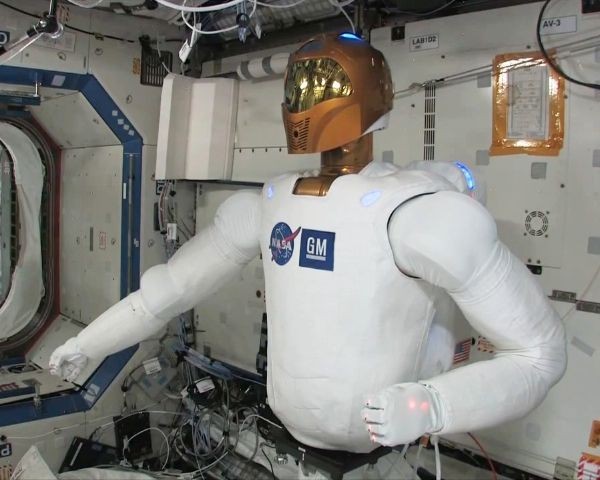
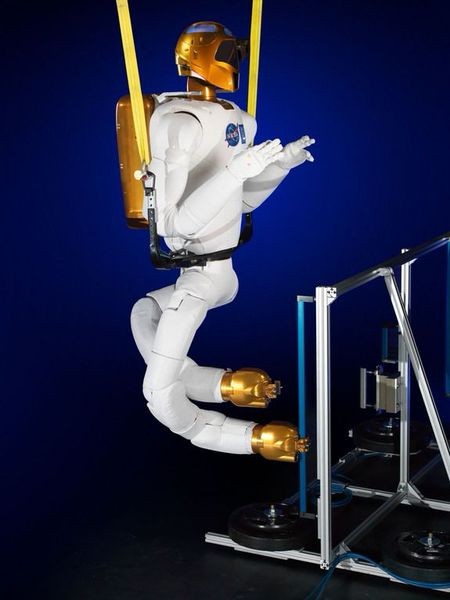
The idea behind robonaut is that it can do tedious or dangerous tasks that humans don’t want to. Imagine, for example, repairing the space station. To that end, robonaut has a special pair of legs (just launched in April) that allow it to attach to railings. It never has to walk -- it is weightless on the space station.
Take a second to think about that -- this would have been unimaginable to me as a kid -- right now we have an android robot on a space station!
But what about thinking robots? Moore’s Law says that the number of transistors on an integrated circuit doubles every two years. Of course, it isn’t really a law in the same way that, say, Newton’s Laws are. It is just a fit to the data, first noticed by Gordon Moore, founder of Intel. But if we extrapolate ahead, in about a decade, computers should have the same processing power as the human brain!
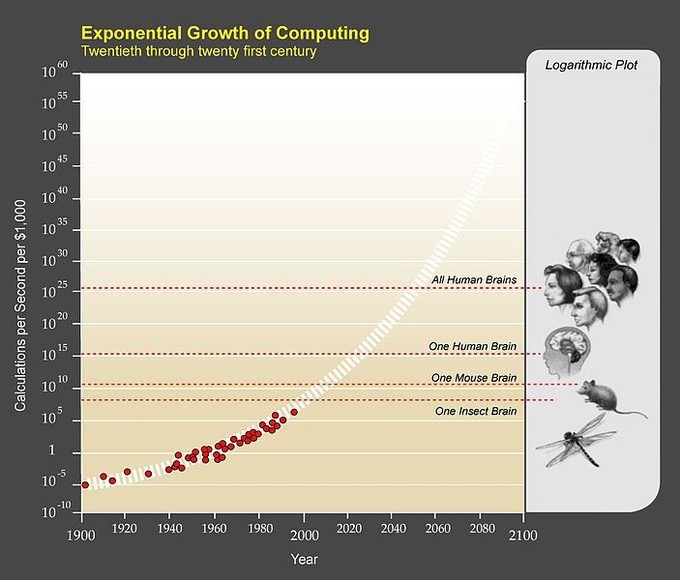
This doesn’t mean that computers will become sentient in 10 years, of course. That’s a software question, not a hardware one. Right now, computers can beat humans at the highly restricted fields of chess and Jeopardy, but it took a long time and a lot of programming to accomplish those feats. It is pretty remarkable that we have something like robotic helpers in our pocket in the likes of Siri, but true Artificial Intelligence will take a lot more work before you’d confuse it with a human.
Tatooine
Tattoine is perhaps most famous for its twin suns. In fact, binary star systems are quite common in the universe. About a third of star systems have two or more stars. But can you have a planet in this configuration? Yes!
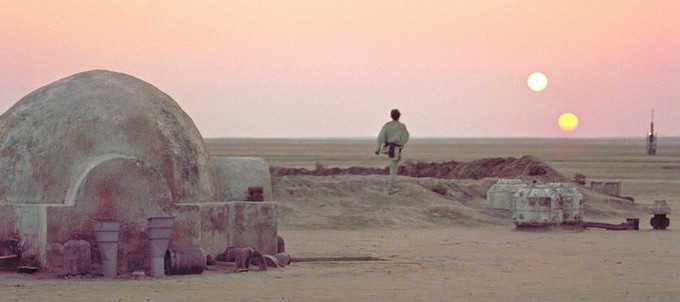
There are two ways this can happen. One is to have the two stars fairly widely separated and have the planet in orbit around only one of the stars (figure below, left). As I explained in an earlier article, this is the configuration in AVATAR, where Pandora is in the real-life star system of Alpha Centauri. Alpha Cen is actually a binary, with two stars: Alpha Cen A and Alpha Cen B. It gets even more complicated, because Pandora orbits the fictional gas giant Polyphemus, which in turn is in orbit around Alpha Cen A. But let’s not worry about that extra complication.
The Alpha Cen system has a period of 80 years, which is the time it takes to complete one orbit. Polyphemus is in orbit around Alpha Cen A, and has a much shorter period (this is governed by Kepler’s Laws, one of which states that the square of the period is proportional to the cube of the average separation between two orbiting bodies). Let’s say Polyphemus takes a year to orbit Alpha Cen A. Then, for about half the year, both of the suns are roughly in the same direction on the sky. So they will both be up in the daytime. But for the other half, the stars will be in opposite directions on the sky. That means that Alpha Cen B will be up in what should be the night time. So it would never get truly dark.
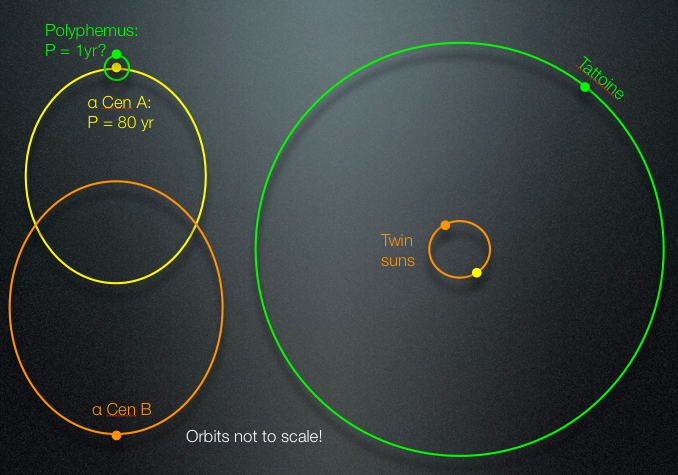
Note that this kind of system had something like a “superyear” -- the binary period of the star system (here 80 years). So while Alpha Cen A would always be the same size in the sky (assuming Polyphemus has a circular orbit around it), Alpha Cen B’s apparent size would fluctuate over the course of 80 years, depending on how far away it was.
From all available evidence, Tatooine is different. The twin suns are in orbit around each other (above figure, right), and the planet is in orbit around the pair of stars (technically around the center of mass of the system). In this configuration, the suns are always close to each other on the sky, so they rise and set at roughly the same time. And they always stay approximately the same angular size. It only fluctuates a little, depending on which star is closer. We can tell Tatooine is probably like this, because the sunset in Episode III and Episode IV are something like 18 years apart, and still both stars set together and have approximately the same angular size.
Note, also, that one star is yellow, and the other is orange. Since the color of the star is proportional to temperature, that means that the yellow star is hotter. That also means it is slightly more massive. However, the more massive star should have a slightly larger radius, and, if they are at the same distance, a slightly larger angular diameter. Since the two suns appear to have the same angular diameter, this means that the yellow star is slightly farther away in its orbit. Of course, the orange star is always seen lower in the atmosphere, and stars appear redder as they set thanks to scattering off of a larger volume of atmosphere.
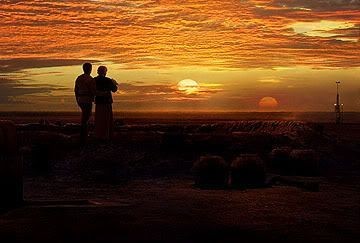
But would planets in either configuration be stable, or would gravitational interaction between the stars and the planet kick the planet out of the system? This happens! One of my first jobs in astronomy, as an undergraduate, was to go through the target list for a Search for Extraterrestrial Intelligence (SETI) project, and get rid of binary stars that wouldn’t have the right configurations to have planets.
In the Tatooine configuration, at least, we know planets can survive, because we’ve discovered similar planets! Kepler 16b is a part-rock, part-gas Saturn-sized planet orbiting a pair of binary stars. The Kepler mission found a pair of stars that were eclipsing each other, but on top of that, another planet was passing in front of each star and dimming the light from it. You can see the data below.
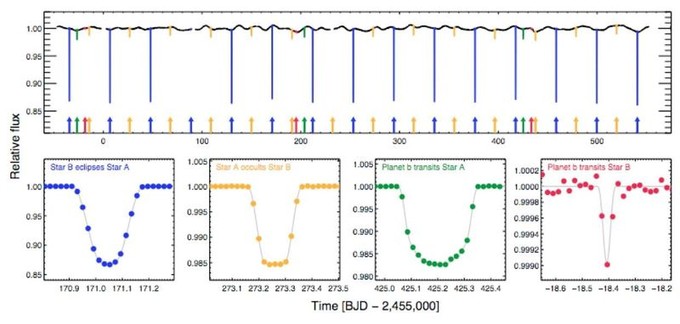
The system is just inside the outer edge of its habitable zone, so if there is a moon around the gas giant planet (like Endor), it is possible that it could sustain life. It is remarkable that we live in a time that we can confirm that there really are Tatooines out there. There may be aliens enjoying a binary sunset right at this moment.
Holograms
We all want to see this!
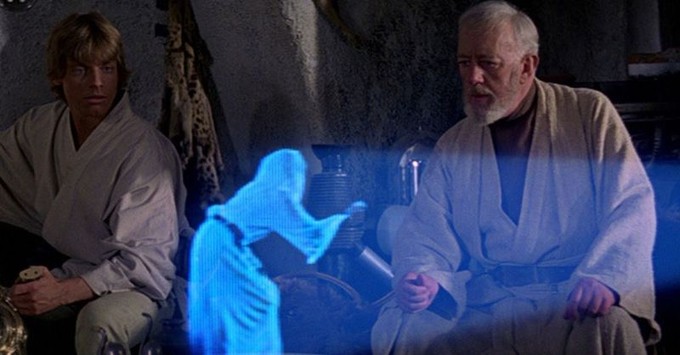
But this “Princess Leia effect,” a 3D projection that you can see from any angle, isn’t technically a hologram. A hologram is created by producing an interference pattern on a photograph. You then reconstruct the 3D image by illuminating the photograph with a reference beam.
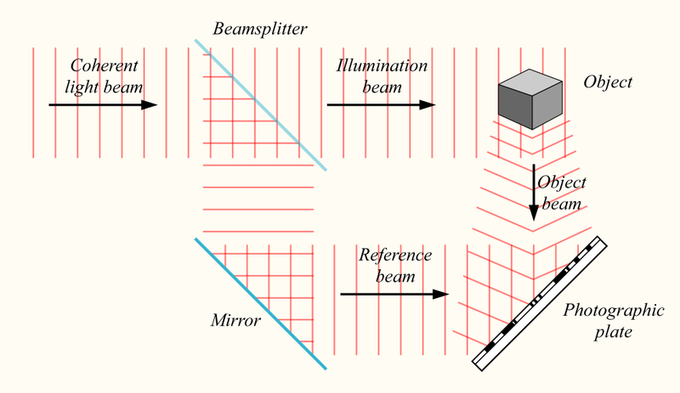
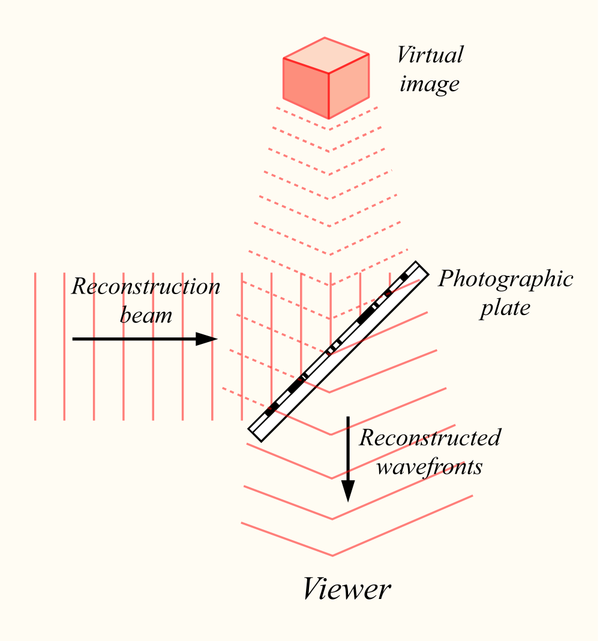
What we really want is a 3D video. One of the closest in recent memory was the Tupac Shakur “hologram” that performed with Snoop Dogg at Coachella in 2012. But this wasn’t a hologram either, it was a version of a century-old illusion called “Pepper’s Ghost.” They created a 3D rendering of Tupac, then, using mirrors, projected it onto a mostly transparent screen.
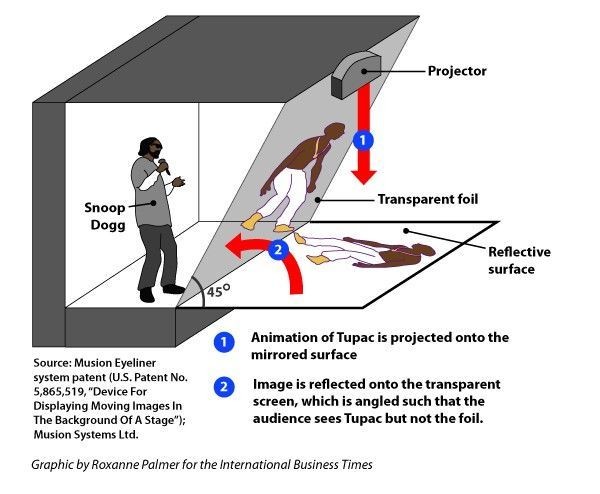
This is the same trick Disney uses in the Haunted Mansion to create the illusion of ghosts. There are actually animatronic versions of the “ghosts” hidden out of sight that get reflected into your line of sight by glass.
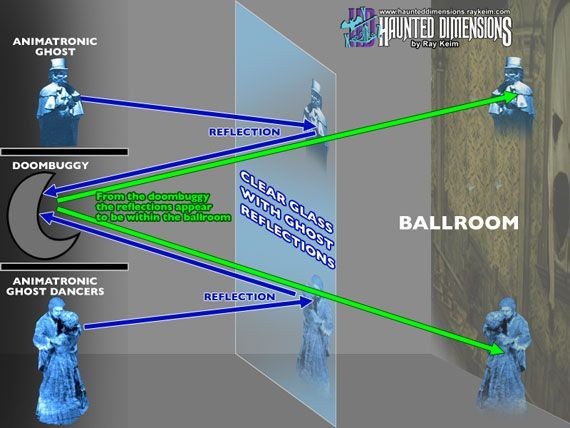
Of course, these aren’t really “3D” -- they are just 2D images projected on a screen to hide the source. To really get 3D images, you need to present a different image to each eye. “Glasses-less” 3D is the holy grail here, and so far, in popular consumer culture, it has only been achieved by the Nintendo 3DS. That works by putting a barrier in front of the screen so that each eye sees a different image.
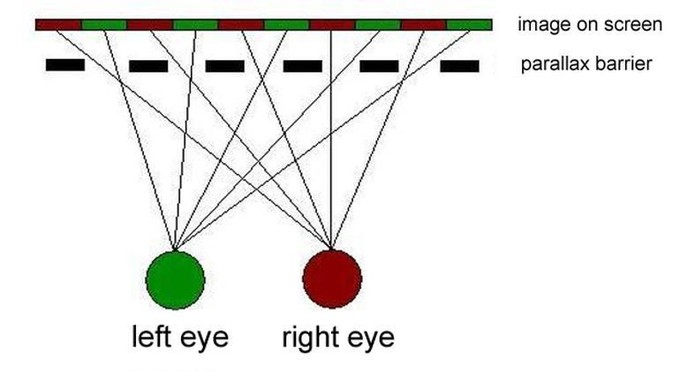
Parsecs
Han Solo says, “You’ve never heard of the Millennium Falcon? It’s the ship that made the Kessel Run in less than 12 parsecs.” But even though it sounds like second, a parsec is a unit of distance, not time. A parsec is the distance a star would have to be so that its parallax is one arcsecond.
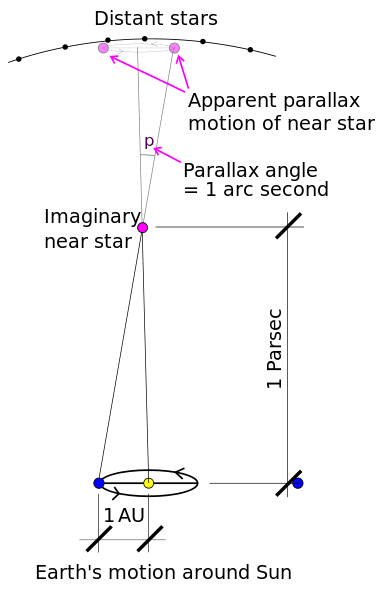
But what is parallax? If you hold your finger in front of your face, and alternately blink each eye, you will see it move in relation to background objects. The same thing happens to nearby stars. As the Earth orbits the sun, nearby stars trace out a circle on the sky (which you can only see with a telescope). When the radius of that circle is one arcsecond, the star is at one parsec.
All you really need to know is that a parsec is equal to about 3.3 lightyears. (It is silly that *both* units of distance sound like units of time).
I know that in the expanded universe people say that the Kessel Run is a race to minimize distance, not time. And some say that Han was bullshitting, either inadvertently, or deliberately. I think all this is all just nonsense to cover for that fact that George Lucas had a very common astronomical misconception that I see over and over again in my class.
Lightsabers
Of course, we still don’t know how to make a lightsaber. One big problem is confining plasma (if that is even what it is), into some tube. But a bigger problem is the amount of energy required. We can actually calculate this from clues in the movies!
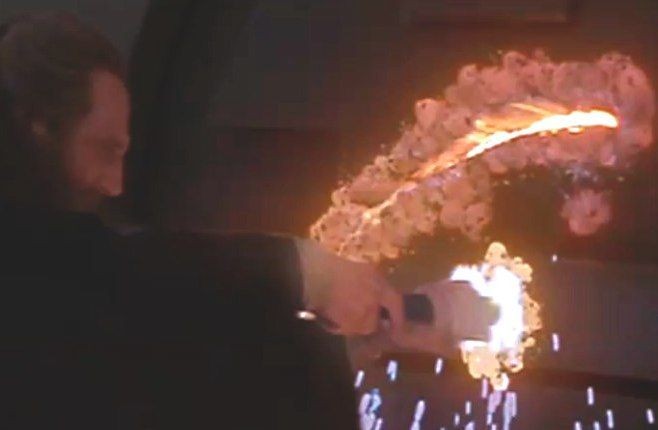
In Episode I, Qui-Gon jabs his lightsaber into a door, and melts part of it. That’s just basic physics! To melt something, you have to raise its temperature to the melting point, and you can calculate how much energy that takes using the specific heat capacity of a material. The formula is:
E=cp mΔT,where E is energy, cp is the specific heat capacity, m is the mass, and ΔT is the change in temperature. Let’s assume the material is steel (it doesn’t matter too much if it isn’t -- we only want to get an order of magnitude estimate, and we are calculating the energy in a friggin’ fictional lightsaber for crying out loud).
First we need to know the mass of steel. It has a density of 8 g/cm3. If we can figure out the volume of the part that melts, we can figure out the mass of steel. I’m going to estimate that the melted part is 30 cm in radius, and 10 cm deep. The volume of a disk is V=πr2d=28,000 cm3, in round numbers. The mass is then the density times the volume, or about 230 kg. That’s about 500 lbs -- makes sense for a good part of a thick steel door. And again, if we’re off by a factor of 2 it doesn’t really matter.
The melting point of steel is about 1370 degrees C. We have to raise it to that from room temperature, about 20 C. So we need ΔT =1340 C, let’s call it 1300 C because we don’t need 3 significant figures.
Finally, we need the specific heat capacity of steel. That’s how much energy it takes to raise a gram of it one degree C. In round numbers, steel has cp = 0.5 J / g / C, where J is a Joule. A Watt is a Joule per second, so a 60 Watt light bulb puts out 60 Joules per second.
Putting this all together, we see that a light saber requires an energy of E=cp mΔT=0.5J/g/C(230,000g)(1300C)= 1.5x108 J. That’s equal to 40 kilowatt-hours, or about as much energy as an average US home uses in a day. Note that this is a only the energy to do this one thing (melt a door) for 10 seconds. If the lightsaber stays on at the same intensity, for say, 2 hours, you need about 700 times that, or as much as a home uses in 2 years. But let’s be conservative and assume you can dial down a lightsaber’s power when you don’t need that much energy. After all, sometimes Luke uses his like a baseball bat to knock people off skiffs instead of slicing them in half.
But what if the door isn’t made of steel? Rhett Alain, at the Dot Physics blog has done a very clever analysis based on the color of the melting door, which you can use to infer a temperature. Everything radiates with a specific color based on its temperature. Hot stars are blue, cooler stars are red. Even humans glow in the infrared. Based on this, he determined that the door is made of some mythical thing that isn’t steel, but has melting properties unlike any Earth-based thing. And just using the cuts that Qui-Gon made, he figured that the power (not the energy, power is the energy per time) necessary is 28 kW. That’s a lot less than I got, but he was considering only the little arc cut, which should take a lot less energy than the massive melting I was considering. (Also, of course the filmmakers were just doing whatever seemed cool, not trying to be physically consistent).
Mr. Alain also used to size of the lightsaber handle to figure out how the energy density a lightsaber battery would have to have. The answer: about a hundred times higher energy density than the batteries in your cell phone. That is, if you packed a lightsaber handle with cell phone batteries, you’d still come up about a factor of 100 short on even this conservative estimate of a lightsaber’s energy needs.
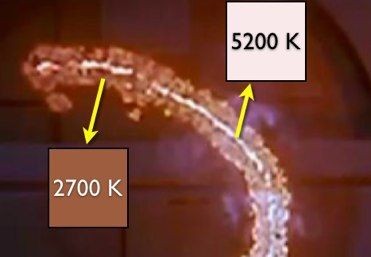
So the Jedi have some awesome power source. Maybe the force? When I was a kid, in the time between STAR WARS and EMPIRE, we used to debate whether or not only Jedi could use lightsabers. We got our answer when Han Solo used one to slice open a Tauntaun in Empire. Well, kind of. After Yoda later said, “There is another...”, many people speculated that since Han could use a lightsaber, maybe he was force-sensitive. Of course, later we found out it was Leia who was the secret Jedi. In retrospect, Leia should probably have been the one out searching for Luke. Her force sensitivity could have allowed her to find him wandering in the snow, and the lightsaber use could have been foreshadowing. But of course, Lucas didn’t know she was going to be his sister when he wrote EMPIRE, or he wouldn’t have left in that (in retrospect) gross brother-sister kiss!
Still, maybe lightsabers can be used in some minimal way by anyone, but to get door-melting energies, you need the force. I like that interpretation -- it has a certain elegance, and would help explain why they are still using swords in an age of blasters.
TIE Fighters
Ok, why are they called TIE fighters? Well, the real reason is that they look like a bow tie, but in continuity the reason is the TIE stands for Twin Ion Engine. They are the red glowing things in the image below.
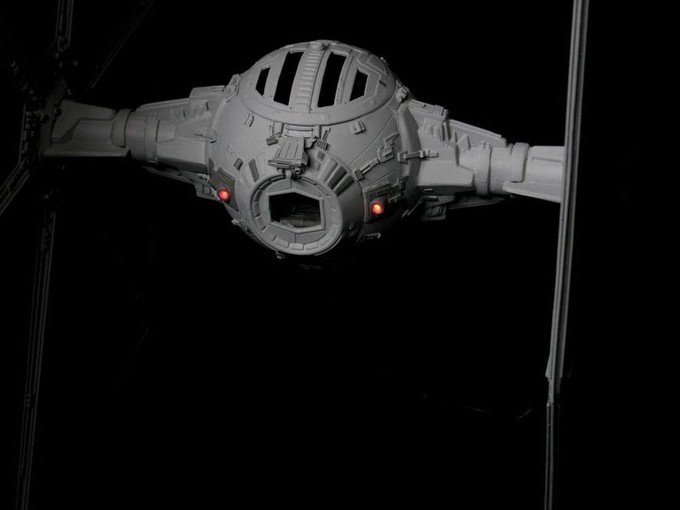
While this was science fiction in 1977, when STAR WARS was released, today we really do have Ion Engines on spacecraft exploring the solar system! They create thrust by accelerating charged particles away from the ship. Often Xenon gas is used.
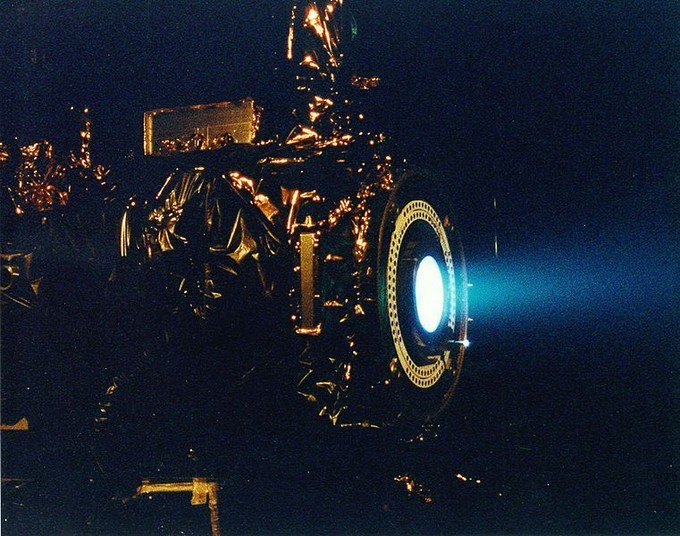
These engines have small thrust (about the weight of a sheet of paper). So they aren’t going to be going fast or changing direction rapidly like we see in STAR WARS. Deep Space 1, the first spacecraft with an ion engine (seen being tested above), could go 0-60 miles per hour in four days. Not exactly zippy, but the trick is that they are thrusting continuously, so speed builds up over time.
But why do you want such a sluggish spacecraft? The advantage is that these engines have a high specific impulse, or propellant efficiency. DS1 changed velocity by 4.3 kilometers per second while using only 74 kg of fuel.
On the downside, these engines require a lot of power. So they require large solar panels to get enough juice. Take a look at these, on the Dawn spacecraft.

Look familiar? For scale and reference, here’s a life-sized model of Vader’s TIE advanced built by fans!

Note that the scale is similar to Dawn, and it has a core spaceship of about a human scale, with what look like solar panels on the side! This blows my mind -- we now effectively have TIE fighters. And the kicker -- they are exploring our solar system, including asteroids, just as they did in THE EMPIRE STRIKES BACK!
Dawn has visited Vesta, the second most massive asteroid in the solar system. Here’s what the asteroid looks like up close, as seen by Dawn. Remember, when STAR WARS was made, we hadn’t even really seen an asteroid up close.
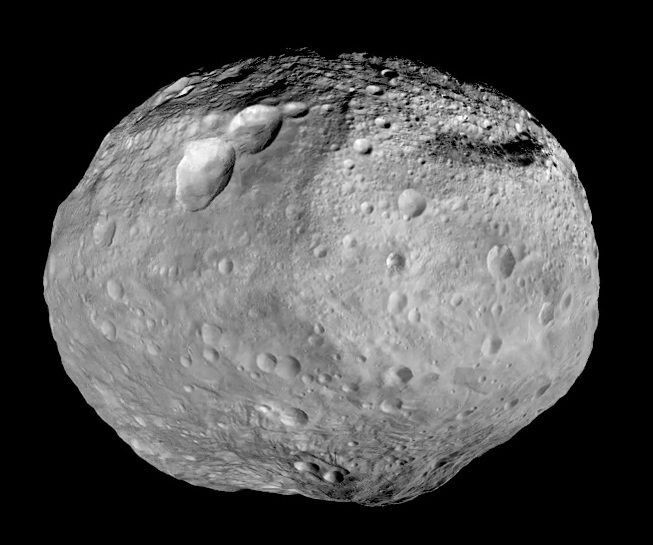
Dawn is on its way to Ceres, the largest asteroid in the solar system, and should get there in April, 2015. Ceres is so large that it is actually spherical, and in the early 1800s, it was considered a planet! Just like with Pluto, once we found more objects in the respective belt (the asteroid belt in the case of Ceres, the Kuiper belt in the case of Pluto), we realized that it wasn’t a planet but the largest member of a class of other similar bodies.
Training remotes
This is one of the coolest things I discovered while researching this story. Remember the training remote on the Millennium Falcon that Luke used to practice his lightsaber skills?
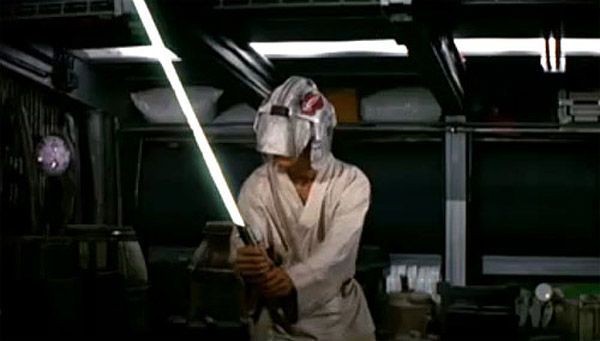
Basically, it hovers and shoots out compressed gas to float around. Here it is up close:
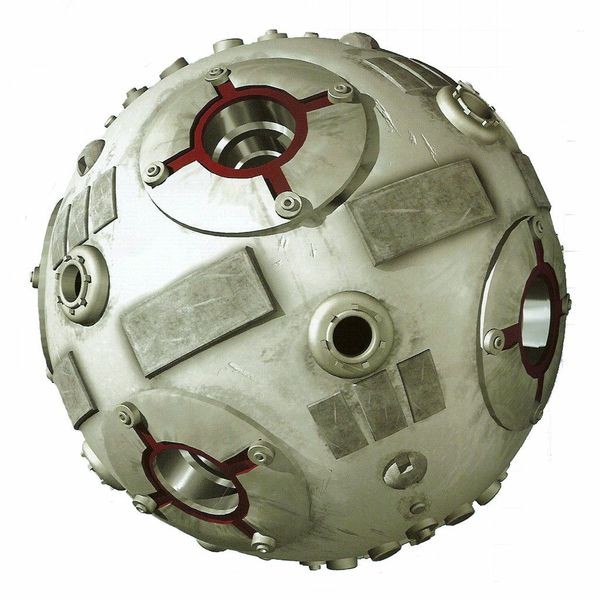
Believe it or not, these things are real and are flying on a spaceship right now! In 1999, MIT professor David Miller showed his students STAR WARS, and when it got to the part about the training remotes, he said, “I want you to build me some of those.” They and subsequent researchers came up with these things called SPHERES that are being tested on the International Space Station. They float because it is weightless on the ISS. And then they maintain their position and move around by shooting jets of compressed air! You can see a video of them in action here.
And here is one up close.
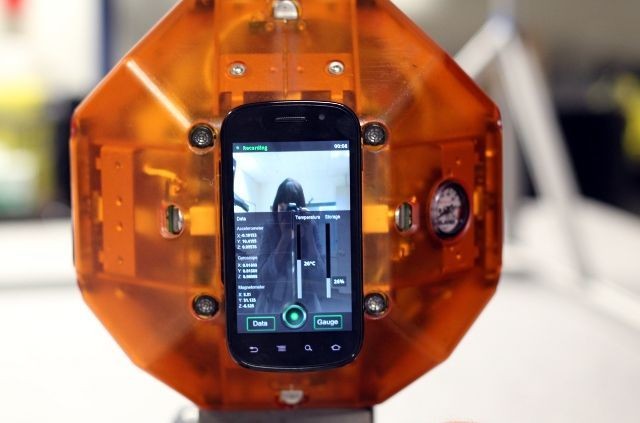
Check that out -- for “brains” you can attached an android phone! So these things really are a kind of droid! The phones allow them to be programmed, have wi-fi, and allow them to see via cameras.
The Death Star
What’s that?
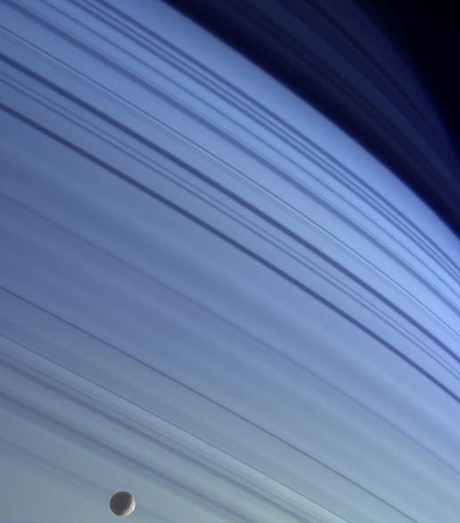
A small moon? That’s no moon, it’s a space station! Ok, actually, that is a real image from the Cassini mission of Mimas, seen against the backdrop of Saturn. The dark lines are the shadows of Saturn’s rings. And Mimas is the closest thing to the Death Star in our Solar System.
Here’s what it looks like up close.
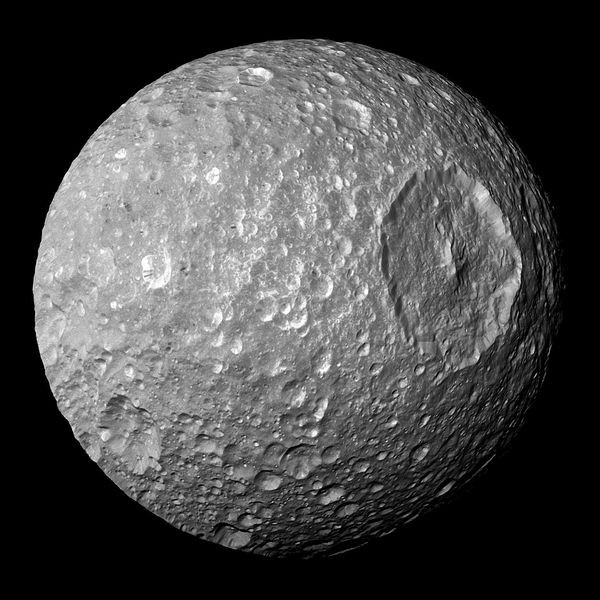
We know it is the right scale, because it is indeed a “small moon.” In fact, it is the smallest body in the Solar System that is round because its own gravity compressed it into a sphere. It is 246 miles in diameter. The thing that looks like the Death Star’s superlaser is a crater named Herschel, named after Sir William Herschel, who discovered Mimas in 1789. But crazily enough, it is just a coincidence that the moon looks like the Death Star. Star Wars came out in 1977, and Herschel crater was not discovered until 1980 when the Voyager probes flew past Saturn.
The Destruction of Alderaan
And now for a scene so famous, people have recreated it in pumpkin form.

Oh yes, the destruction of Alderaan! In STAR WARS they imply that this is the first time they have used the laser to blow up a planet. Can you imagine that? We know they were building the Death Star for 18 years, since we saw it being constructed when Luke was born. After nearly two decades of hard work -- of constructing an artificial moon that can house a million troops and fly through hyperspace, they test fire the laser for the first time, and it *just works* and blows up a planet!
When our heroes were running around the Death Star, they should have been continually running into engineers high fiving each other saying, “Oh my god, did you see that? It worked! I can’t believe it! I am so fucking pumped right now!”
Or maybe they were like the scientists on the Manhattan Project -- they created the technology because they either felt they were facing an existential threat from the rebels, or they just wanted to do it for the pure science of it. But then it got into the hands of the politicians, and a guy with a mechanical windpipe and a dominatrix outfit, and the rest is history.
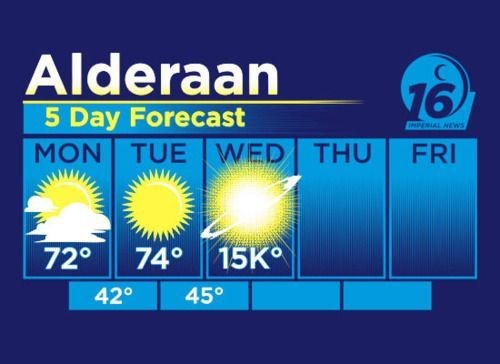
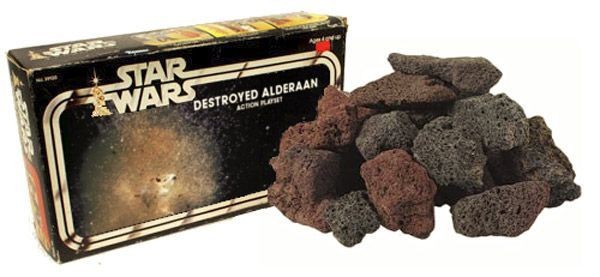
But how much energy would it take to blow up a planet? We can calculate this! This is just the binding energy of the planet --the energy it takes to hold it together. That is:
U=3GM2 / 5R, where U is the binding energy, G is the gravitational constant, M is the mass of the planet, and R is the radius. We don’t know how big Alderaan is, but let’s say it is about the size of Earth (it doesn’t matter too much for our calculations).
Plugging the mass and radius into the equation gives us a binding energy of about 2 * 1032 Joules! To put that in perspective, that is a billion times more energy than in all the fossil fuel on Earth, a hundred million times more than in all the uranium on Earth, and is equal to the total energy output of the sun for about a week!
So when Vader says, “The ability to destroy a planet is insignificant next to the power of the force,” he is *such* a goddamn liar! He can’t think apart a planet! I mean, it takes him like 5 seconds just to choke someone.
Nine beams combine in the Death Star laser. That makes each one about 1031 J. This is the daily energy output of the sun at the surface, from all over the sun. That makes these guys the dumbest guys in the universe.
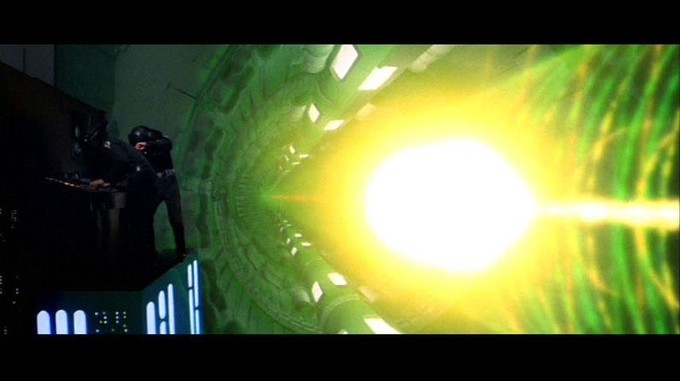
They’d just be Death Star Engineer vapor at that point! There is no need for the rebels to destroy the Death Star now. Everyone who knows how to run the damn laser just got evaporated by the first test firing.
Which brings us to this idea:
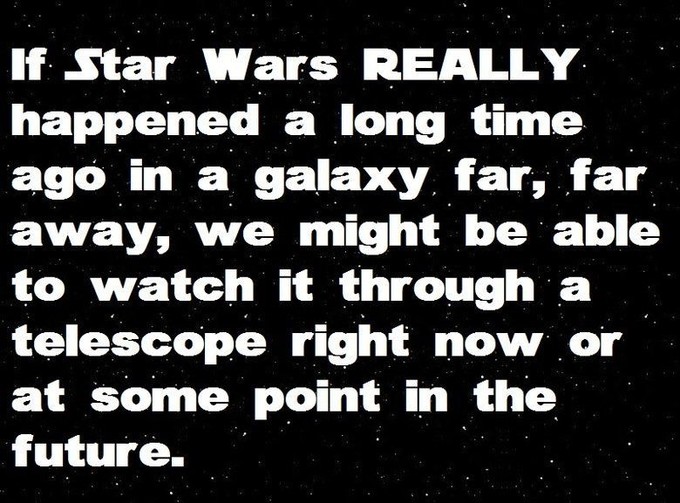
Is that true? Kind of! I calculated it. Take the destruction of Alderaan -- it would radiate about 10 billion times less energy than a supernova. The closest galaxy to us, the Large Magellanic Cloud, hosted supernova 1987A a few decades ago. That supernova was so bright you could see it with the naked eye. But at that distance, the Destruction of Alderaan would just be at the limit of what you could see with a reasonable exposure time with the Hubble Space Telescope. So I don’t know about a “A Long Time Ago in Galaxy Far, Far Away,” but you could see it if it happened in a “Galaxy Close, Close By, About 163,000 Years Ago.” The LMC is 163,000 lightyears, or 50,000 parsecs away. And unlike Han Solo, I know what those are.
- Copernicus (aka Andy Howell). Email me or follow me on Twitter.
